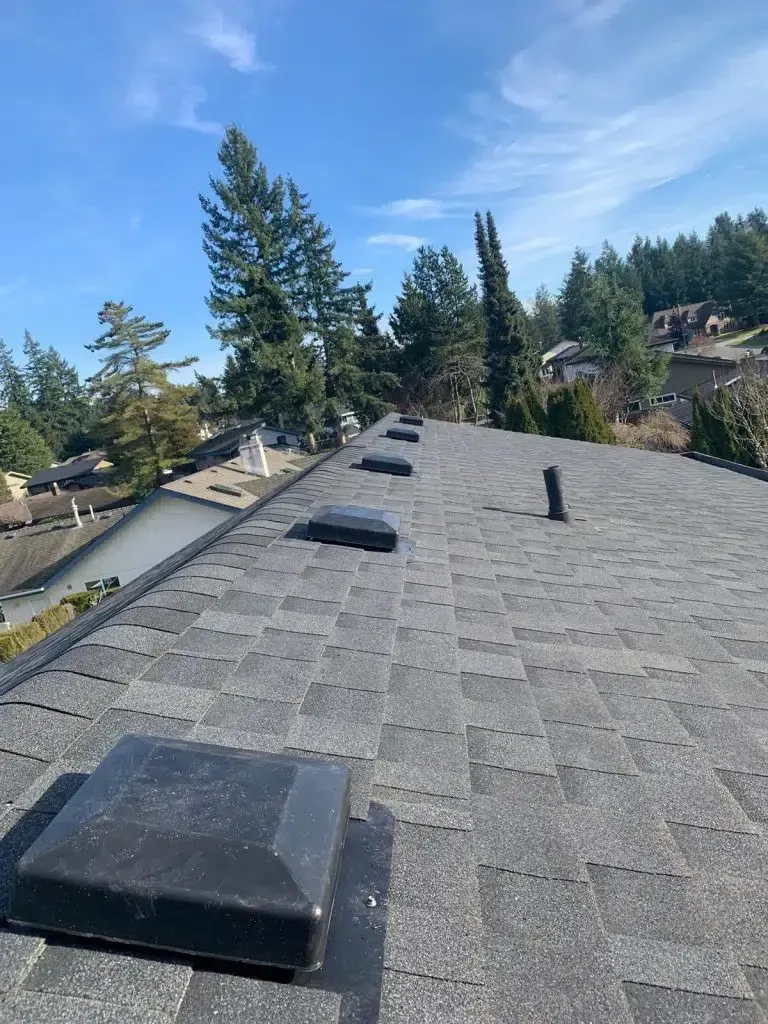Seasonal Roof Maintenance Checklist for Surrey Homeowners
Seasonal Roof Maintenance Checklist for Surrey Homeowners
Surrey’s wet-to-mild climate demands a seasonal roof maintenance checklist for Surrey homeowners so minor issues stay small and your roof lasts decades.
- Clear gutters and downspouts.
- Remove moss and debris.
- Check shingles and flashing.
- Trim overhanging branches.
- Schedule professional inspection.
| Season | Key Task | Why It Matters |
|---|---|---|
| Spring | Debris sweep | Prevents moisture pockets |
| Summer | Seal flashing | UV heat accelerates cracks |
| Fall | Gutter flush | Stops ice dams later |
| Winter | Attic check | Detects hidden condensation |
Introduction: Where Rain Meets Ridgecaps
Surrey, BC, drinks in nearly 1 400 mm of annual rainfall—enough to test even the stoutest roof. I’m Harman from Paragon Roofing BC, and after twenty storm-soaked years on local ladders I can confirm one truth: set-and-forget roofing fails fast here. Surrey’s unique pairing of Pacific moisture and Fraser Valley wind gusts punishes neglected shingles, warps flashing, spawns moss jungles, and drives leaks into living rooms. A disciplined seasonal roof maintenance checklist turns that threat into a non-event. Below you’ll find a 2 000-plus-word deep dive—equal parts science, story, and step-by-step field notes—crafted specifically for homeowners south of the Fraser. If you’d rather leave the ladder work to pros, explore our Surrey seasonal roofing maintenance services.
1. Climate Snapshot: Why Surrey Roofs Age Differently
Surrey’s weather profile swings between soggy shoulder seasons and sun-bleached midsummer afternoons. March and November are rain champions, each averaging 170 mm. July dips below 40 mm yet spikes to 26 °C under cloud-burning UV. Add salty breezes riding inland from Boundary Bay and you have a recipe for:
- Accelerated asphalt granule loss (rainfall abrasion).
- Premature sealant shrinkage (UV and thermal expansion).
- Flashing lift-off during southeast windstorms that flirt with 60 km/h gusts.
Local context matters because a checklist that works in Kamloops simply under-serves Surrey.
2. Spring Reset (March – May)
The equinox brings cherry blossoms—and a perfect window to evict winter’s mess before summer heat bakes it in.
2.1 Debris & Moss Patrol
Surrey’s Douglas-fir needles love valley gutters. Waiting until June means those needles compost into acidic sludge that chews aluminum. Slip on gloves, scoop by hand, rinse with a low-pressure hose. Never blast with a pressure washer; it shoves water under shingle courses.
2.2 Shingle-by-Shingle Scan
Look for:
- Curling edges —signs of freeze-thaw fatigue.
- Missing granules —appears as dark bald spots.
- Exposed nail heads —future leak beacons.
Replace compromised pieces immediately; patching later in rain makes adhesion flaky.
2.3 Flashing & Sealant Check
Spring’s moderate 10-15 °C temperatures let polyurethane sealants cure perfectly. Re-caulk chimney saddles, skylight perimeters, and plumbing vents. Tap metal flashing; if it rattles, drive in gasketed screws.
2.4 Skylight & Solar Tube Clarity
Pollen clouds coat lenses, muting daylight. Use a non-abrasive glass cleaner. Fogging between panes signals failed seals—call a pro for re-glazing before mold colonizes.
3. Summer Fortification (June – August)
Bluebird skies tempt complacency, yet this is prime time to bulletproof surfaces while they’re bone-dry.
3.1 UV Armor Application
Surrey hits a UV index of 8 in July. An acrylic roof coating can drop shingle surface temperatures by 10 °C, slowing asphalt oxidation. Select a product with 88 % solar reflectance and ASTM D6083 approval.
3.2 Attic Airflow Audit
Hot air trapped under decking hits 50 °C. Measure with an infrared thermometer at noon; anything > 38 °C screams poor ventilation. Correct by:
- Adding continuous ridge vents.
- Ensuring soffit intakes remain unobstructed by insulation.
- Installing solar-powered exhaust fans if geometry restricts passive flow.
3.3 Fastener Tight-Down
Heat expands metal, loosening screws. Walk every metal-to-wood connection—especially on standing-seam accent roofs over bay windows—and snug until washers compress flush but not split.
4. Fall Defense (September – November)
Leaves fall, roofs grieve—unless you prep.
4.1 Gutter Flush & Leaf-Guard Check
Attach a gutter scoop to a painter’s pole, scrape, then flow-test for 10 seconds per 10 feet using a garden hose. Install micro-mesh gutter guards where maples overhang; they outperform foam inserts that foster moss. Need a broader strategy? Our storm prep Surrey guide covers wind and rain proofing in detail.
4.2 Ridge & Hip Inspection
Autumn windstorms funnel through Mud Bay and slap ridgelines first. Verify cap shingles sit tight and that ridge vent filters remain intact. Replace missing end-caps to stop sideways rain intrusion.
4.3 Tree-Canopy Trim
Overhanging cedar branches drip tannins that stain shingles. Keep limbs 3 m back. Hire an ISA-certified arborist; amateur cuts invite disease and can boomerang onto the roof.
5. Winter Vigilance (December – February)
Snow here is fickle—rare, then sudden. That unpredictability breeds complacency.
5.1 Snow Load Awareness
Most Surrey roofs are engineered for 1.0 kN/m². Wet Pacific snow can exceed that fast. If accumulation tops 20 cm of wet snow, rake from ground level using a telescoping plastic-edge rake. Avoid chipping ice—hammer strikes shatter shingles.
5.2 Ice-Dam Proofing
Freeze-thaw cycles around 0 °C create dams. Ensure attic insulation hits R-60 and that heat sources (pot lights, bathroom fans) are gasketed to prevent heat leaks that melt snow unevenly.
5.3 Condensation Patrol
Cold outside, warm inside. Inspect attic rafters for frost beads on clear mornings; persistent moisture indicates ventilation imbalance. Install additional gable vents or convert soffit screens from 1/8-inch to 1/4-inch mesh to double airflow without inviting rodents.
6. Material-Specific Watchpoints
| Material | Surrey Risk | Maintenance Hack |
|---|---|---|
| Asphalt shingles | Granule wash-off in heavy rain | Install splash guards at valleys |
| Metal panels | Salt-laden mist corrosion | Rinse with neutral-pH soap bi-annually |
| Cedar shakes | Moss colonization | Apply copper-naphthenate spray every 3 years |
| Torch-on membrane | UV chalking | Re-topcoat with SBS-compatible acrylic |
7. DIY vs Pro: Drawing the Line
Surrey homeowners often climb ladders in summer, but some tasks scream professional intervention:
- Torch-on membrane repairs —open flame risks voiding insurance.
- Steep-slope moss removal —requires fall-arrest systems.
- Structural sag diagnosis —hidden rot demands invasive probing.
Hiring certified installers (we carry RCABC Red Seal credentials) keeps warranties intact and lungs safe from spore inhalation.
8. Budgeting the Calendar
Spread costs, not panic. Typical annual spend for a 2 000 ft² gable roof:
| Task | DIY Cost | Pro Cost |
|---|---|---|
| Spring debris removal | $50 tools | $250 service |
| Summer coating | $450 materials | $1 200 full system |
| Fall gutter guard | $4/ft | $9/ft installed |
| Winter emergency rake | $70 kit | $300 visit |
Plan a staggered schedule: tackle DIY tasks first, then bank seasonal savings for big-ticket pro items.
9. Sustainable & Tech-Forward Extras
Surrey’s Green City initiatives reward eco-conscious retrofits. Consider:
- Rainwater harvesting —redirect clean runoff into 200 L barrels, reducing water bills.
- Drone inspections —thermal imaging pinpoints heat loss without foot traffic.
- Smart moisture sensors —embed under underlayment; receive leak alerts on your phone.
Municipal rebates cover up to 30 % of device costs.
10. Common Surrey Myths—Busted
- “Summer repairs can wait until fall rains.” False. Adhesive integrity halves in cool, damp conditions.
- “Moss is just cosmetic.” Wrong. Rhizoids pry shingles apart, multiplying leaks.
- “Metal roofs never need maintenance.” Almost. They shrug off moss but crave fastener checks and cathodic protection in salt-spray zones.
11. Safety Blueprint
Work above grade? Respect gravity. Wear CSA-approved fall harnesses rated to 5 000 lbs, anchor to a ridge-cap-mounted D-ring, keep lanyard slack < 6 ft. Use soft-rubber ladder stand-offs on gutters. Check Environment Canada’s wind advisories; postpone if gusts > 30 km/h.
12. Frequently Asked Questions (Beyond Snippet)
Q: How often should I treat my asphalt roof for moss in Surrey?
Every 24 months; earlier if north-facing or shaded.
Q: Can I install heat cables to stop ice dams?
Yes, but only after sealing attic air leaks; cables are a Band-Aid.
Q: Does homeowner insurance cover wind-blown shingle loss?
Most policies do, yet carriers may deny claims if maintenance lapses are proven.
13. The Paragon Field-Tested “Four-Season Stopwatch”
We’ve honed a timing trick: pick one task and one coffee break per season. If a chore exceeds the time it takes to drink a cappuccino on the porch (≈ 15 min), schedule a pro. This keeps workloads digestible and roofs trouble-free.
Conclusion: A Roof That Outsmarts the Weather
Surrey’s skies won’t cut your roof any slack, but diligence trumps downpour. Follow this seasonal roof maintenance checklist for Surrey homeowners and you transform rainfall from a threat into a harmless soundtrack. Need backup? The Paragon Roofing BC crew is one call away—boots laced, harnesses ready, experience earned on thousands of Valley rafters. But whether you DIY or delegate, remember: small steps, taken on schedule, secure the dry, cozy home you deserve.
References
- BC Building Code, Part 9 (2024 Revision).
- Environment Canada Climate Data – Surrey, BC Weather Station (1981–2020 Normals).
- RCABC Roofing Practices Manual, 2023 Edition.
- ASTM D6083 – Standard Specification for Liquid-Applied Acrylic Coating.



